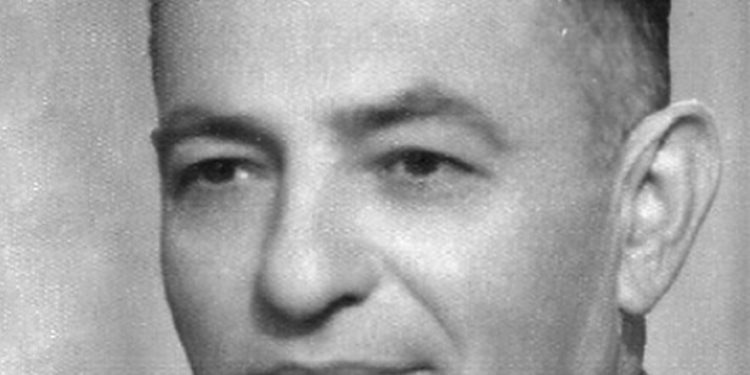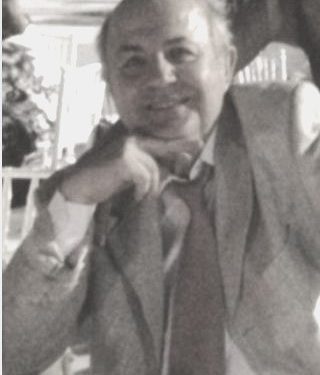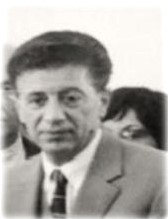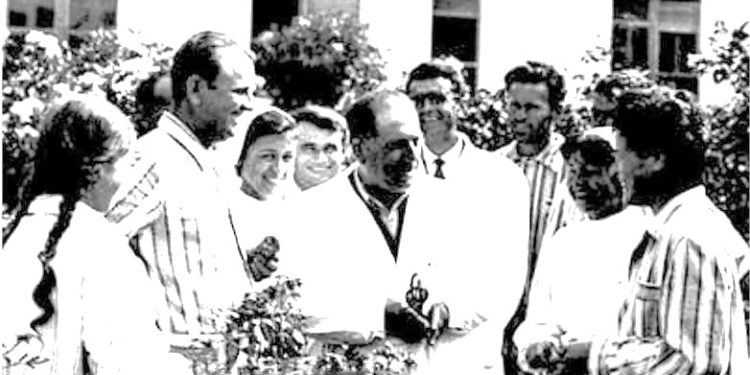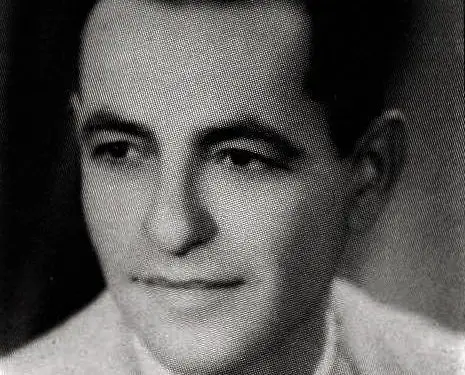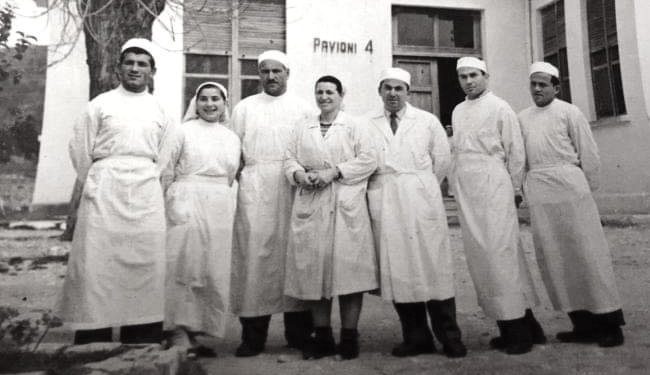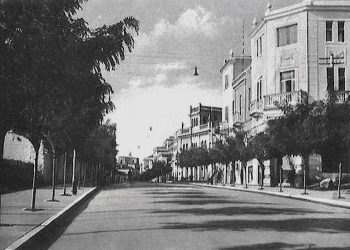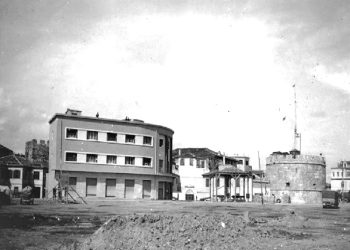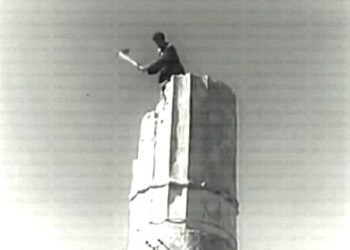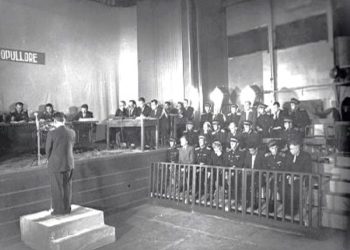By DR. EDUARD A. SKUFI
In memoriam …
Memorie.al / Their icons need no introduction; time has given their respective surplus value to their work. But I would like, with this homage and gratitude, in a retrospective vision, but resized after three decades of absence, but not oblivion, to focus on some components and principles from the impact of the collaboration and the unique experience, with two prominent figures of the distinguished constellation of doctors in Vlora, Dr. Isuf Hysenbegas and Dr. Petref Kallfa (based on my professional diary).
Specific school, duet of dignified and reputable rank, genuine model of application of the ethical code, which together with figures of such dimensions, distinguished co-ordinates, should become the object of a complex analysis, as; “illuminating point of reference and inspiration for the present and future of medical sciences”.
They, not by chance, had many elements in common, starting from the way of patriotic education in high school and higher studies, Dr. Isufi graduated from the University of Rome, while Dr. Kallfa, initially at the University of Bologna and then at that of Bucharest, with a diverse polyhedral culture, which was incorporated into their humanitarian spirit, with high ethical standards.
After returning to their homeland, their youthful dreams were confronted with the scenes of the “theater of the absurd” of Machiavellian improvisations and with the “bourgeois” labeling until their epilogue. Without losing hope, with faith and optimism, with the charismatic strength of personality and the principles that guided them, they “reflected knowledge and culture”…!
… My memories travel to the first days of January 1980, the prologue of my career, as an Ophthalmologist at the Vlora Hospital. There I found Dr. P. Kallfë, our meeting was rather typical and discreet, but with respect, (as always when confronting the young with experience). He gave me an exposition of his medical evolution and experience on ocular plastic interventions, which I had been informed were his preference. During the conversation I asked him about the surgical technique in glaucoma and he replied telegraphically that he applied the classical methods.
A very diplomatic ping-pong was spontaneously taking place, but I was “playing by protocol”. After examining the patients and discussing the cases, he greeted me and left. I was describing the repertoire in the clinical charts, when after a light knock on the door Dr. Isufi entered the room, elegant in a beige suit and brown tie (classical vestiario style), as always with a smile and a wise word, he rested his hand on my shoulder and, looking attentively at the charts, said to me:
“You have a precious privilege, you write beautifully. The charts have scientific value for all time, ‘scripta manent’ – he added. I would suggest that you keep a diary, with the most interesting cases, which, over time, will acquire great value, it will be like a ‘score in verse’” – he told me… (And that day I started it). Then he opened his leather bag and left me on the table some books, which he had borrowed from my father’s library.
“Books are my passion – and, differentiating one of them, he continued – this, here is the excellent and famous book by M. Montessori ‘Manuale di pedagogia scientifica’, a synthesis of the philosophy of modern education, on ethical and pedagogical scientific concepts, her life begins, and here medicine begins”! I approached you and whispered “Montessori or Makarenko”…?! – “Controversial concepts, different points of view”, he added with a smile. I read deep thought in the expressiveness of his gaze and the retrospective of memories traveled to my childhood years!
My father, an experienced but idealistic teacher, had inherited a rich library of pleasant Italian and French literature.
This was the reason why many renowned intellectuals of that time came to our house, who periodically borrowed books. Distinguished doctors dominated, who made the environment pleasant with their stories and jokes (such as Dr. A. Ashiku, Dr. Babani, Dr. P. Flloko, Dr. I. Pustina, Dr. V. Çili, Dr. I. Hysenbegasi, less often Dr. K. Kauri, Dr. M. Angjeli and Dr. P. Kallfa came). There I met Dr. Isufi for the first time, as an auto mechanic, and Dr. Kallfa as an ophthalmologist, who in the future I would have prestigious colleagues!
Their presentation began with gentleness and politeness in behavior and was completed with elegant classical aesthetics, charming but serious. Their special communication was not just an educational element, but also a way to transmit ideas. It was a real fact that they did not distance or separate general medicine from their respective specialties, on the contrary they insisted on the basic concept “that it was the quintessence, while the specialties were the bridge of unification”. Something that was reflected in medical consultations, where they stood out for their logic and scientific intuition. It was strange but admirable that although they were special specialists, neither stethoscopes nor medical vade medums like “Roversi” were missing from their personal bags.
The collaboration with their duet was a chance that life offered me to invest in the path of progress and perfection. Their suggestions and advice transcended the limits of knowledge, changed the perspective, helped in the real perception of the philosophy of life, which radiated into that of the applied medical philosophy.
It was essential to benefit from the “in vivo” experience of colleagues of such a sequence, who predominated and inspired with their reflections, like a “virtual kinetic encyclopedia”. I was impressed by the fact that, as kind and good-natured as they were towards the positive, they were as harsh and incompatible with mediocrity in medicine, which they considered a serious handicap!
… I remember it was a typical winter day in 1984, when I had just returned from the scientific symposium of the university clinic of Ophthalmology, where my paper on “Malignant Glaucoma” was positively evaluated. After we greeted Dr. Kallfa in a friendly manner and exchanged news, we began to discuss the patients.
Dr. Kallfa was preoccupied and worried about a patient with hemolytic anemia, diagnosed with retinal ablation, expressing skepticism about the diagnosis with which he was sent by the polyclinic! He asked for my opinion and I visited him without wasting time, thinking about subretinal hematoma. He agreed with me with a; “yes”, as if freed from anxiety. “Do you agree to consult this particular case with the hematologist”, he added?!
“Absolutely,” I replied, “it is the only solution”. He quickly managed it and performed the consultation. The case was not simple, but the correct diagnosis completely changed the therapeutic tactics. The consultation was interesting, after the applied treatment, the hematoma was quickly reduced, and vision was restored. Clinical management and the criteria for determining therapy in cooperation with the relevant specialist became not only a lesson in experience.
My passion as a subspecialty aimed at studying and investigating Glaucoma, for this purpose I was going to the library, after having ordered an American treatise on modern glaucoma surgery from the Academy of Sciences. At the entrance to the library I met Dr. Kallfa with “Minerva Medica” in hand; we talked for a while and greeted each other. After I took the book and studied it, I differentiated the goniotrepanation intervention with the scleral flap of Prof. J. Fronimopoulos. I began the preparatory procedure and the plan for its application.
Dr. Kallfa not only encouraged and promoted me, but also gave me the opportunity to apply it to some patients, his friends. “Safe and effective intervention that avoids the complications of traditional surgery”, underlined Dr. Kallfa. “It is important; to do well what you have to do, this is philosophical, but at times the intensity of the routine, robs us of peace”- he added. “Or in the original; Fais bien ce que tu fais”, I intervened. “You brought me the rematch, with the aphorism from Orison Marden’s book, which you have in the library”, – he said laughing.
I gradually, with the widespread application of this method, created my integral experience, which became the evolutionary basis of a medical monograph on dynamics, for the investigation of glaucoma. Isufi, apparently, informed about this, one day after visits to the polyclinic, while chatting, said to me: “Bravo, Soyez realiste, cherchez l’impossible! Mark in your agenda, tomorrow my friend from Çeprati, who has only one eye and the one with glaucoma, which you diagnosed, will come.
The unfortunate one, he is also persecuted, but this does not matter to us doctors, he is a sick person and must be helped. I have complete confidence in you”, – he told me. Then he continued in a low voice: “Did you like the romantic film ‘Doctor Zhivago’ by Pasternak on TV last night? What a realization, when ordinary things leave extraordinary impressions”, and he looked away: “Man is a labyrinth, mysterious. There is no analysis without psychoanalysis” – he added. “Freud”? I asked. “And not only, but with the synchronicity of Jung and the metaphysics of Kant” – he said!
One of the greatest values of these figures was the ability to predict and detect something, much earlier than others. The moment came when I would operate on Dr. Isufi’s friend, on his only eye, the responsibility was too great. That day I went to the hospital earlier, after visiting the patient, I calmed him down and with the way of communication; I gave him a kind of psychotherapy.
After a while I started the operation, the nurse of the room assisted me, since Dr. Kallfa had to go to the clinic for a visit. I could only hear the ticking of the clock and the ticking of my heart. At that moment, someone carefully opened the door, where I could see Dr. Isufi’s gaze through the mask, and I nodded to him to come in. He followed me with his observant eyes. After a few minutes, the operation was completed without any problems.
The satisfied patient thanked us, and Dr. Isufi, shaking my hand, said to me in confidence: “A fine and delicate operation, but without obvious trauma. The most valuable thing you can do for your colleague is not only to share your experience with him, but to explore and support his skills and talent,” he said declamatory! “Dear Doctor,” I added. Next time, colleague, I will decode the philosophy of life in the sense of the medical one with such finesse”!
…The romance of the mysterious autumn of 1985, with its shades of yellow and brown on the green background, had laid its carpet. I was contemplating this attractive landscape from the window of the doctor’s room, when I heard Dr. Kallfë’s voice, asking for the patient from Fier to be brought to the examination room. He greeted me; he was in an elegant image dressed entirely in gray, contrasting with a sax blue tie, with a decorative brooch. “Comme il faut”, “You have entered the role,” I said, “ready to interpret”. He added, laughing: “Today I will be on stage … but not only, because I appreciate you very much”.
At that time, the nurse entered, carrying a young girl of about 20 years old, with a face deformed like a mask, where the severe consequences of a burn were outlined. Dr. Kallfa examined her, explained in detail the stages of the intervention that would be applied and, in the meantime, took a photo of her ‘en face’ and profile. After we finished the general examination, we went into surgery.
We decided to combine the effectiveness of local anesthesia with partial anesthesia, with ‘Fentanyl and sedatives’. For this, we sought the help of the surgical anesthesiologist, who with “intoxicating anesthesia” introduced the patient to the world of dreams. Dr. Kallfa hung the pre-prepared sketch on a tripod like a true painter, to continue as a sculptor, in that complex plastic surgery.
He operated on the eyelid to correct the entropion (by stuttering the motif of a classical melody), while I was nearby, in parallel preparing the conjunctiva from the numerous scars, at that moment the dentist surgeon, the well-known Dr. LI. Gjidede, arrived, who would prepare the flap from the oral mucosa, which would serve as an auto-plastic graft, to coat the palpebral and bulbar conjunctiva. It was a complicated operation with coordinated actions, after almost three hours; the operation was completed without problems and with a positive result.
Time would confirm the degree of success. Dr. Kallfa was satisfied; it seemed that he was the “maitre” of these interventions in his repertoire. He fixed some shots on the camera again, and then gave the appropriate advice for this specific case, to the head nurse.
When we entered the room, I congratulated him and said: “Today you were a real actor and conductor”. “These operations require harmonious, efficient cooperation and the tuning of all the staff mechanisms”, – suggested Dr. Kallfa and called to bring a cake, as an expression of pleasure.
…I never differentiated intellectual qualification from professional scientific qualification which I constructed on the triptych of qualitative collaboration, with Dr. Kallfen for classical ophthalmology, with the university ophthalmology clinic for modern ophthalmology and with Dr. A. Aron for pre-modern and transitional ophthalmology (investing in different experiences). Thus the days passed as if without realizing it, our friendship and relationships became closer and more solid. When I was with them, I seemed more utilitarian, older, because they, with their inductive vision, had minimized the age difference, the only thing that separated us.
They were in “asymmetry with the surrounding level and moreover constituted an exception”. But when had I not thought of the fact that one day they would no longer be…! Today, I perceive these eminent figures as images where the philosophical elements of Plato are harmoniously combined with the ethical humanism of Hippocrates’ deutology, in the creative Albanian spirit, as a “traditional asset”. Because the specificity, in the art of authentic medicine, consists in the complex character of the divine and the natural, in a harmonious and inseparable correlation!
In them, the “coexistence of drama with triumph” was hidden backstage, personalities “without official titles”, but with supreme titles from the masses. Their medical vision, devotion and humanism with which they treated patients, were harmonized in an admiring collegial parallelism.
They devoted with affection to people, to medicine, everything of value such as: wisdom, capability, selflessness, but exclusively the “human spirit”, remaining forever as significant erudite assets! Doctors with influence and academic values who placed excellence as an autograph on their work, as a “synonym of a professional lyricism”.
Precious emblematic figures who emit light and inspire without limit… light which inspired and stigmatized my vision too! A Thank You for them in this memorial is inadequate, insufficient. Gratitude and appreciation will remain eternal! Memorie.al




